Weekly ecommerce tips, deals & news.
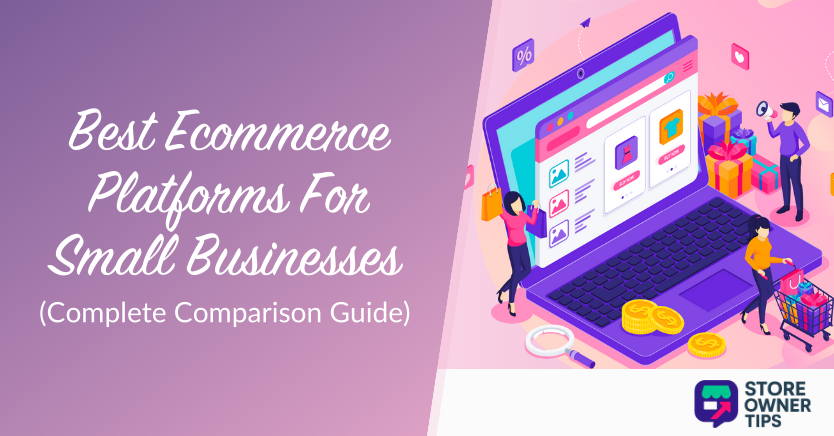
Over 2.77 billion people are projected to shop online in 2025, and the ecommerce industry is expected to hit $8 trillion by 2027. There’s no better time than now to build your online presence, especially if you’re a small business owner ready to grow!
First things first: where do you start?
I’ve got you! In this guide, I’ll walk you through the best ecommerce platforms for small businesses. Each review includes personal insights, standout features, and clear recommendations so you can pick the right one based on your needs, skills, and goals.
Let’s get right into it!
Short on time? Check out this quick overview:
| Platform | Pricing | Key Features | Best For | AI Tools |
| WooCommerce | Free plugin + hosting + optional paid extensions/plugins | High customization, huge plugin/theme ecosystem, full ownership of store/data | WordPress users, full control | Plugins like StoreAgent |
| Shopify | From ~$39/month | Fast setup, app marketplace, polished themes, multi‑channel selling | Beginners, fast launch | Shopify Magic |
| Wix | From ~$27/mo | Drag‑and‑drop editor, visual design freedom, templates, includes analytics & marketing tools | Creatives, design-first stores | AI Writer and Website Builder |
| Squarespace | From ~$27/month | Elegant templates, built‑in SEO & analytics, all‑in‑one, good design control | Aesthetic brands, small stores | Squarespace Blueprint AI and AI content |
| BigCommerce | From ~$39/mo | Unlimited products, strong B2B/wholesale features, APIs & integrations, built‑in multi‑channel selling | Scaling brands, wholesale | BigAI tools |
Regardless of what type of product you decide to sell online–digital goods, handmade crafts, physical inventory, or even services–you’ll need a storefront to showcase them, accept payments, and manage orders. That’s what ecommerce platforms are for. Simply put, they’re tools that help you launch and manage an online store.
Most ecommerce platforms offer the basics out of the box: product listings, shipping setup, payment options, and promotional tools like coupons or discounts.
While comparing these platforms, I quickly realized that there’s one for every kind of store owner. Some tools were easy to use but lacked flexibility. Others had powerful features but felt overwhelming to set up. That’s why it’s crucial to choose a platform that matches not just your products, but also your budget, tech experience, and long-term goals.
Here’s why picking the right ecommerce platform matters:
As a small business owner, your time and energy are limited as you often wear multiple hats. That said, you’ll want a platform that supports your goals and won’t overwhelm you with unnecessary complexity.
These are the key areas I paid close attention to while testing the best ecommerce platforms for small businesses:
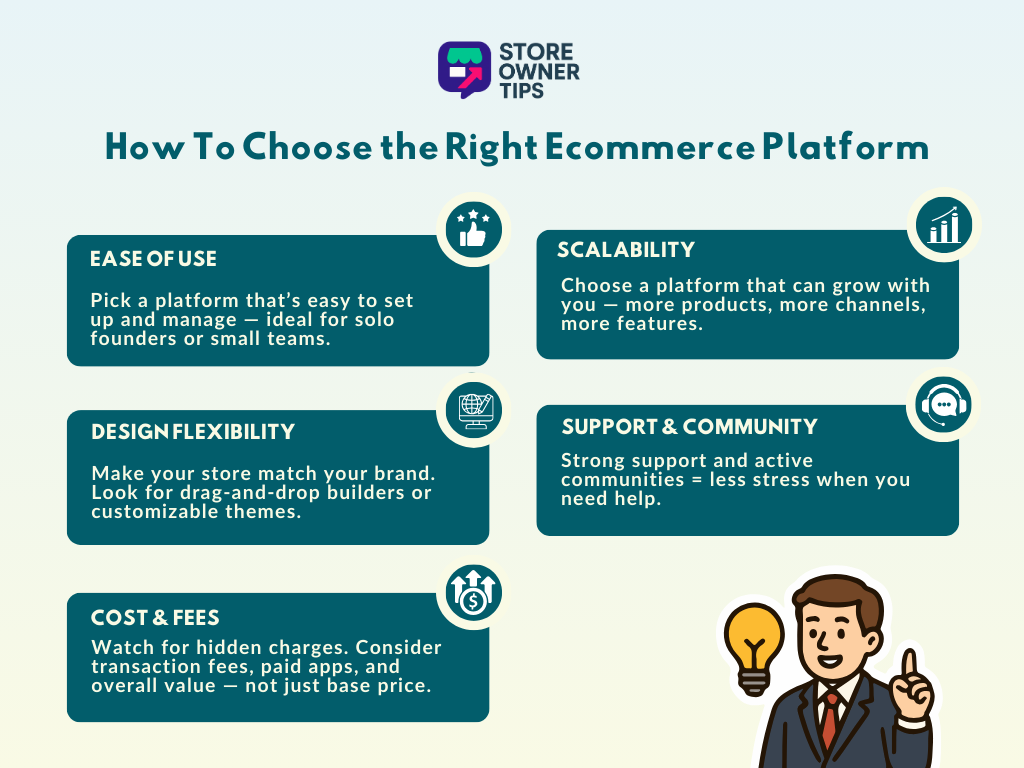
One of the first things I checked was how quickly I could get started. The best platforms guide you step-by-step, making it easy to add products, update pages, and track orders. If you’re a solo founder or working with a small team, this one factor alone can save you hours each week.
Look for ecommerce platforms with intuitive dashboards, easy-to-follow onboarding flows, and helpful documentation or live chat support (more on this later).
Your storefront should be able to reflect your brand. Some platforms offer drag-and-drop builders, while others offer customizable themes. Both can work, but the key is finding a platform that gives you control without overcomplicating things.
If you’re looking to scale, having the option to expand your design later (like adding custom sections or switching layouts) is a huge plus!
Cost is a huge consideration when you’re just starting out. Thankfully, you have a lot of options: some platforms offer low-cost plans that work well for simple setups, or monthly pricing tiers that can scale with your needs. It’s not always about choosing the cheapest option, but more so which gives you the best value based on how you plan to sell.
💡 POWER TIP: Factor in payment gateway fees, hidden transaction percentages, and the cost of premium themes or apps. They can add up, especially when you’re beginning to scale.
Can your platform support you when you’re starting to scale? I kept an eye on platforms that offer extra room for growth. For example, some tools make it easy to upgrade your plan or integrate with social media channels and marketing systems.
If you plan to launch more products along the way or sell across multiple channels, scalability will save you from having to migrate to a whole new system later.
For small business owners who might not have a tech team to lean on, solid support and an engaged community can make a huge difference. Some platforms offer live chat support and thorough documentation that guides you step-by-step. Community forums are also a huge plus. Sometimes, the best tips come from fellow users!
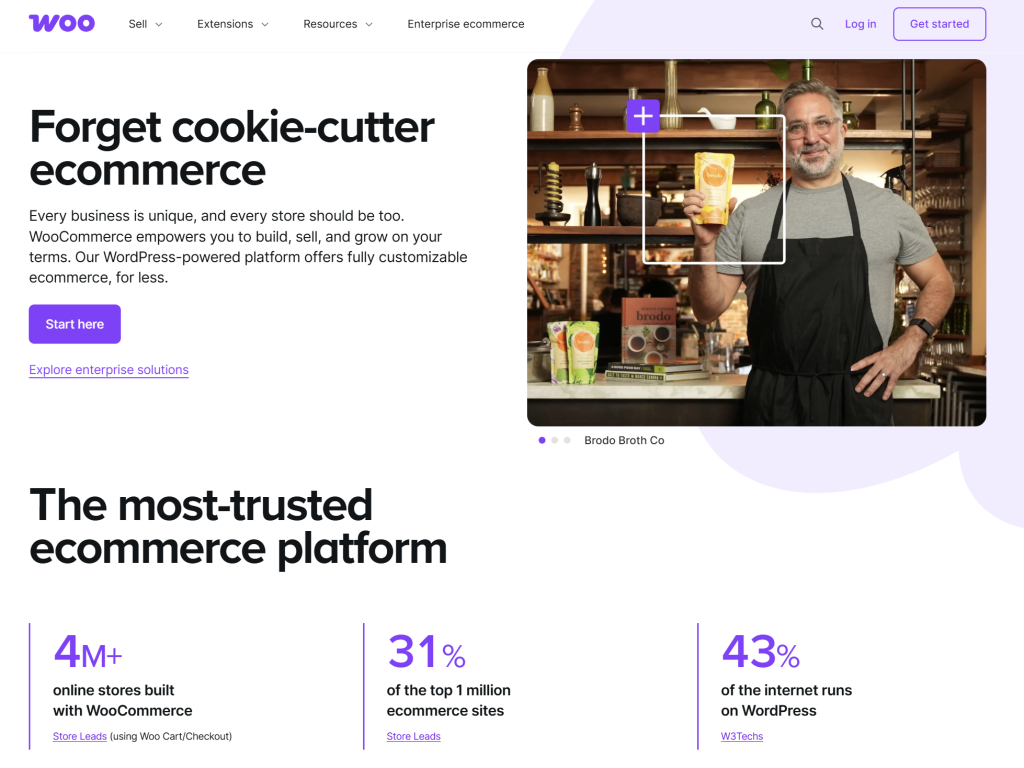
At present, WooCommerce powers over 4 million stores, making it one of the most popular ecommerce platforms out there. It’s a free, open-source plugin for WordPress that transforms your website into an online store. If you’re already familiar with the WordPress ecosystem (or plan to build your website there), WooCommerce is likely the most natural starting point!
The plugin itself was easy to activate. After installing it on my test site, I was guided through a setup wizard that helped me configure basic store details, like currency, shipping options, and payment gateways. From there, I could explore other plugins and extensions for advanced features like discount rules, loyalty programs, or wholesale pricing.
What stood out to me immediately was this platform’s flexibility. I could change layouts, add custom sections, and even install marketing plugins directly inside WordPress. The tradeoff is that there’s a slightly steeper learning curve if you’re new to using WordPress. However, once you get past that, the level of control and customization is commendable.
| Pricing: | Free plugin (self-hosted) Hosting starts around $5–$15/month Optional premium extensions range from $0–$300+ |
| Standout Features: | ✅Seamless integration with WordPress ✅Highly customizable with thousands of plugins and themes ✅No platform lock-in: you own your store and data ✅Large global community and developer support |
| Who I’d Recommend This For | Store owners who already use WordPress or want full control over their store’s design, features, and data. Great for bloggers, creators, and brands that plan to scale with content or custom workflows. |
Shopify is one of the most beginner-friendly platforms I’ve tested, and I get why it’s considered one of the best ecommerce platforms for small businesses.
After signing up, I was immediately walked through an easy, step-by-step onboarding flow: choose your store type, give it a name, add your first product, set up payments, and launch. Everything felt thoughtfully designed for first-timers.
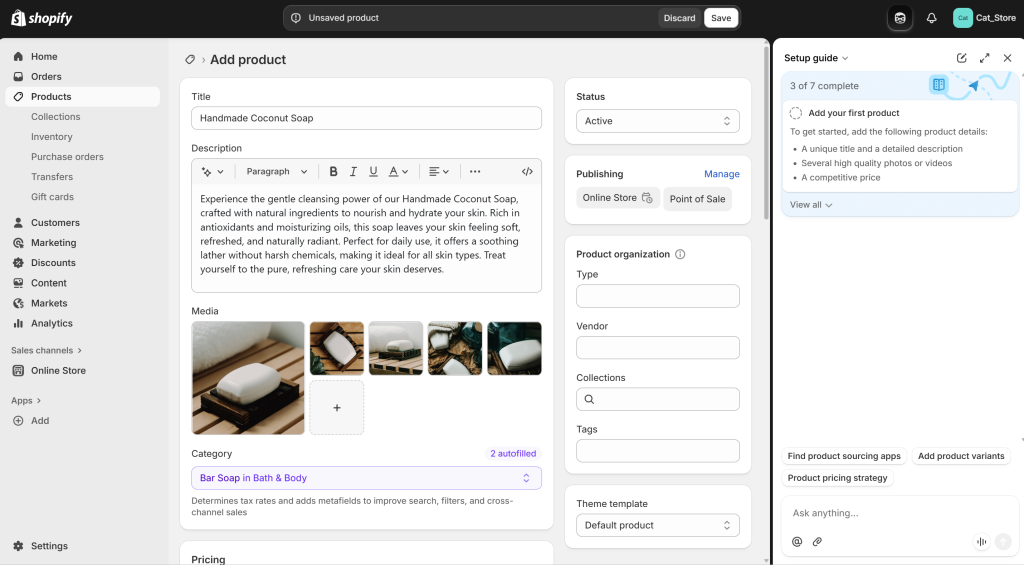
The store dashboard is intuitive, with clearly labeled sections and helpful tooltips. I also appreciated how they offer AI tools to help you create optimized product descriptions. It’s a huge time saver, especially if you have a large catalog.
Of course, this simplicity comes with some trade-offs. You can’t always customize certain store details (like checkout design or B2B functionality) unless you upgrade to a higher-tier plan or install apps. However, if your priority is launching fast and focusing on sales without getting stuck in tech headaches, Shopify is a strong contender.
| Pricing: | 🔹Free trial for 3 days, then starts at $19/month (Basic plan) 🔹2.9% + $0.30 per online transaction with Shopify Payments 🔹Optional additional costs for premium themes and paid apps |
| Standout Features: | ✅Fast, beginner-friendly setup with guided onboarding ✅Modern themes (with both free and premium options) ✅Central dashboard for products, orders, shipping, and payments ✅Huge app marketplace for extra features |
| Who I’d Recommend This For: | Small business owners who want to launch quickly and don’t want to deal with the tech-heavy side of running a store. It’s ideal for people who value design, simplicity, and having everything managed from one clean dashboard. |
Wix is another popular beginner-friendly website builder. What stood out to me while testing was how easy it is to turn a “blank canvas” into a beautiful online store. It features an intuitive drag-and-drop editor, AI tools, and templates that make setup easier. I appreciated the option to use Wix’s AI assistant to describe my business and customize my store based on the type of products I planned to sell.
After the initial setup, you gain access to a clean dashboard and a step-by-step store setup guide that makes navigation easy. For product creation, I tried their AI-text creator tool, which saved me tons of time when writing my mock listings.
Take note that some advanced features (especially things like very custom filtering or specific checkout modifications) require higher‑tier plans or extra apps. But for small stores that want a smooth design experience without heavy tech work, Wix delivers a strong all-in-one solution.
| Pricing: | Paid ecommerce plans start at around $27/month (Core Plan), with higher tiers unlocking more storage, analytics, and advanced features. |
| Standout Features: | ✅Drag-and-drop site builder with full visual control ✅AI-powered store setup and product description tools ✅Built-in features for product variants, coupons, and analytics ✅Huge theme library with beautiful, modern designs App marketplace for extending functionality |
| Who I’d Recommend This For: | Small business owners, creatives, or solo founders who want a visually polished storefront without needing to touch code. Perfect for boutique shops, lifestyle brands, and anyone who values design freedom and fast setup. |
Squarespace is a platform that helps store owners build their websites quickly. As I was testing this platform, I was impressed by how elegant and intuitive the interface felt.
Setup was smooth: the platform offers a “Blueprint AI” functionality that walks you through the initial design process. I answered a few questions about my brand, selected my fonts, color palette, and layout. After setting the basics, I was redirected to a dashboard where I could start adding products and setting up shipping and tax settings.
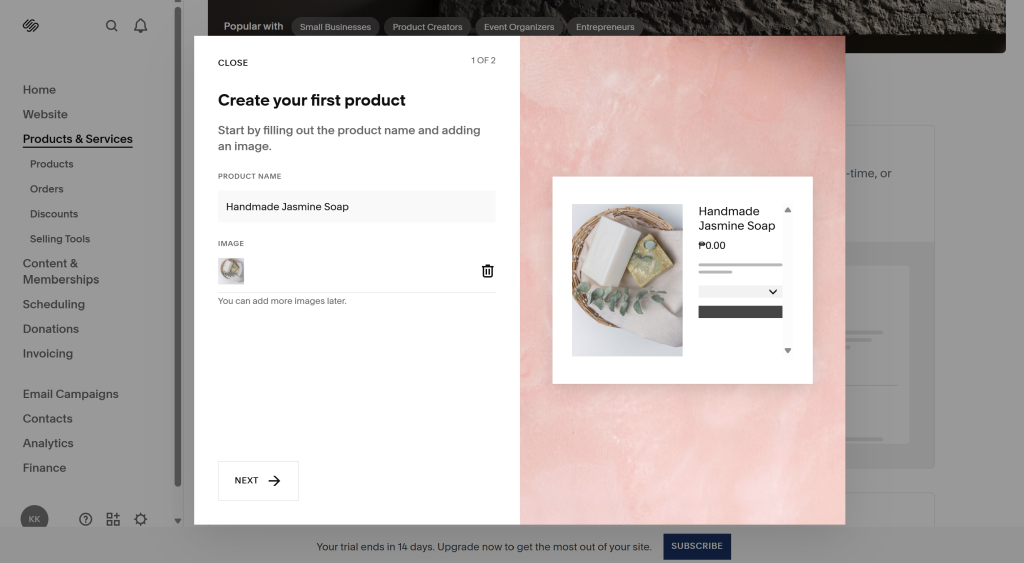
What I liked was how many features are built in from the get‑go (SEO settings, SSL, marketing tools), so I didn’t feel like I needed a ton of add‑ons just to get started. It’s a strong choice for small to mid‑sized stores that prioritize aesthetics and basic ecommerce function.
However, if you plan to have very large product catalogs, very custom checkouts, or require lots of third‑party integrations, you might hit limitations unless you upgrade plans or supplement with external tools.
What I Liked:
| Pricing: | 🔹Free for 14 days, then starts at $14/month (Personal Plan), but ecommerce features begin at $20/month (Business Plan). 🔹Higher-tier plans like Commerce (Basic & Advanced) offer more tools for growing stores and advanced checkout features. |
| Standout Features: | ✅Sleek, mobile-optimized templates ✅Built-in SEO, marketing, and analytics tools ✅AI-powered “Blueprint” setup flow ✅All-in-one platform (hosting, SSL, domain, blog, ecommerce) |
| Who I’d Recommend This For: | Squarespace is among the best ecommerce platforms for small businesses that prioritize design, simplicity, and speed. If you’re launching a visually-driven brand and want an elegant online presence without the overwhelm, this is a great option. |
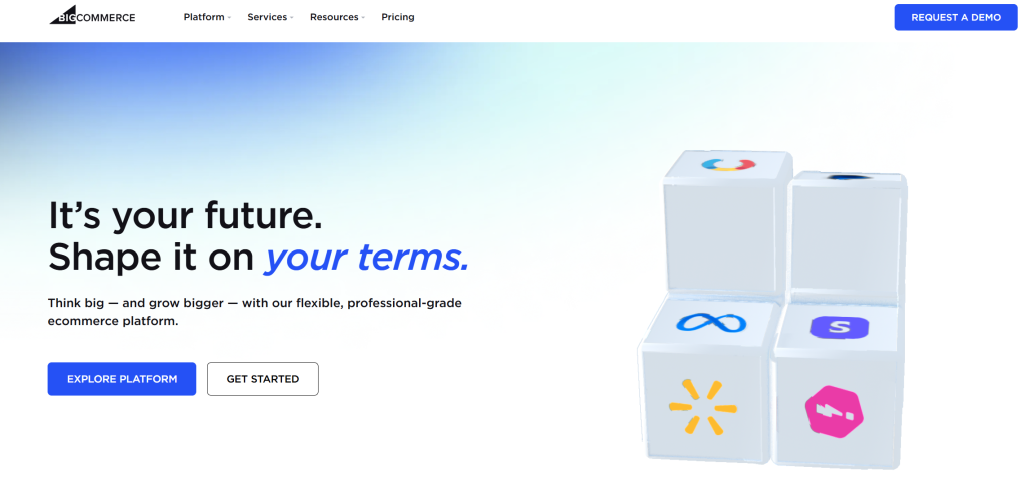
BigCommerce is packed with powerful ecommerce features and is marketed for fast-growing businesses or brands with ambitious goals. It’s clearly made for store owners who want to expand and scale.
What impressed me most was how many advanced tools were available right out of the box. After inputting my basic store information, I was redirected to a centralized dashboard where I could manage products, set up payment gateways, configure shipping zones, and explore multi-channel selling options (like Google Shopping, Facebook, and Amazon).
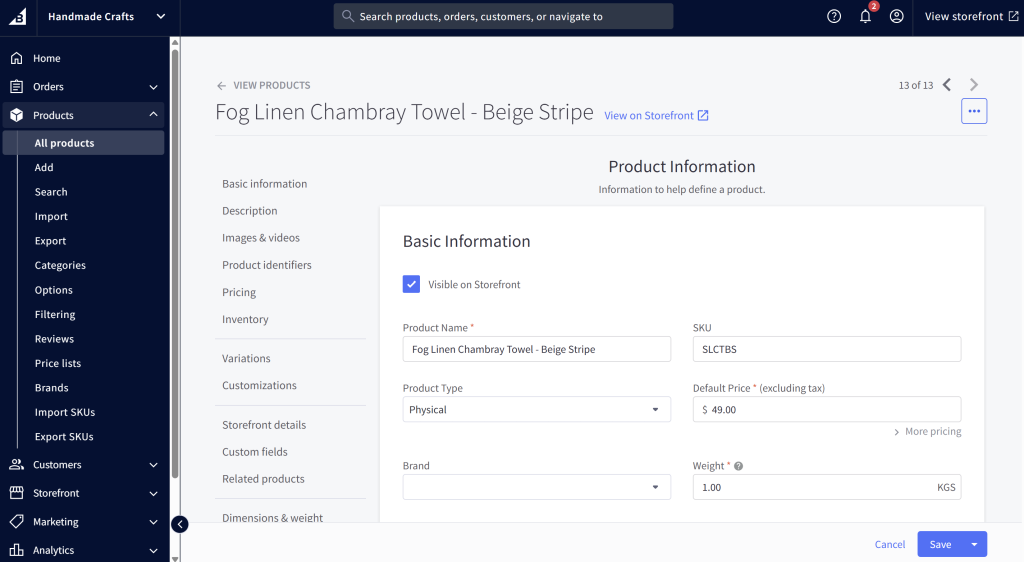
The options available felt robust, which can feel a little bit overwhelming if you’ve never used a full-featured ecommerce system before. Still, the layout is clean, and most sections come with helpful tooltips and links to documentation. For testing, I also explored their B2B features like customer group pricing and found them to be fairly easy to set up.
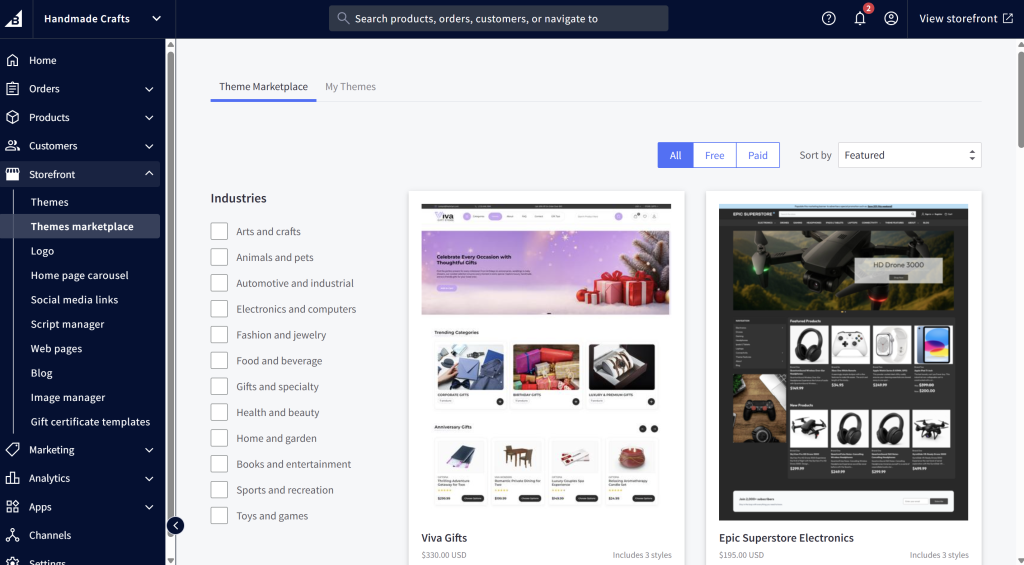
BigCommerce might have a steeper learning curve than Shopify or Squarespace. Advanced features (such as complex filtering or B2B functions) might take more time to master. You may also occasionally run into limitations in how much you can customize page layout without paying for higher plans or specific theme capabilities.
But for small businesses looking to scale or sell in different marketplaces, BigCommerce is worth checking out.
BigCommerce At A Glance
| Pricing: | 🔹Starts at $39/month (Standard Plan). 🔹 Higher plans unlock features like advanced filtering, custom pricing, and priority support. No additional transaction fees, which is great for scaling stores. |
| Standout Features: | ✅Unlimited products and staff accounts across all plans ✅Built-in tools for B2B/wholesale pricing, real-time shipping, bulk discounts ✅Multi-channel selling with native integrations for Amazon, eBay, Meta, and Google ✅Strong SEO control (custom URLs, sitemaps, metadata, etc.) ✅Headless commerce support for advanced customization (for dev-savvy teams) |
| Who I’d Recommend This For: | BigCommerce is ideal for small to medium-sized businesses that already have traction and want to scale, especially those planning to sell across multiple channels or launch wholesale/B2B options later on. |
This depends on your specific goals and tech experience. Platforms like Shopify and Wix are often easiest to start with for beginners. WooCommerce is a strong contender if you’re already familiar with WordPress or want to have full control and flexibility over your store.
Start by identifying your goals, budget, tech comfort level, and where your business is at. The best ecommerce platforms for small businesses are the ones that match your stage and vision. If you want full control and flexibility, go for an open-source solution like WooCommerce. If your priority is launching quickly and easily, Shopify, Wix, or Squarespace are strong options. And if you’re planning to scale fast or offer wholesale pricing, BigCommerce is worth exploring.
WooCommerce is often the most affordable if you already have a WordPress site. The plugin itself is free, and you can choose your own hosting, themes, and add-ons based on your budget. Platforms like Wix and Shopify Starter also offer entry-level plans, but the features vary, so compare what’s included before deciding. Just keep in mind that costs can add up with paid themes, apps, and transaction fees, so take some time to look at what’s included in each plan before committing.
Probably one of the most important decisions you’ll make as a store owner is which ecommerce platform to use. As we’ve seen, the best option really depends on your needs, goals, budget, and stage of business growth.
In this guide, I tested five of the most popular platforms to understand what it feels like to set up a store as a beginner:
Each one has its strengths, and I hope this walkthrough helped you get a clearer picture of what’s possible. 😊
Copyright © StoreOwnerTips.com. All Rights Reserved.